Physical Address
304 North Cardinal St.
Dorchester Center, MA 02124
Fenestrated and branched endovascular aortic aneurysm repair (FBEVAR) uses endovascular aortic devices altered to preserve flow to the renal, visceral, or brachiocephalic vessels while excluding aortic pathology in the region of these vessels. The first description of this technique involved the treatment of short-neck infrarenal abdominal aortic aneurysms (AAAs) using fenestration for the renal arteries to extend the proximal seal. , Since then the use of FBEVAR has steadily increased. Initially, uncovered bridging stents were used to maintain fenestration to target vessel alignment. Bridging stent grafts are now preferred due to their ability to supplement aortic seal while providing improved renal artery patency.
Since its inception, FBEVAR has been primarily performed in large-volume tertiary care centers. This reflects the complexity of the technology and the investigational nature of these devices. In the United States, FBEVAR was initially confined to centers with access to company-manufactured devices through industry-sponsored clinical trials or to centers with FDA-approved physician-sponsored investigational device exemption (PS-IDE) trials. However, since FDA approval of the Zenith Fenestrated Device (Cook Medical, Bloomington, IN) in 2012, fenestrated technology has been made more broadly available for its application to short-neck AAA in the United States. Additional off-the-shelf devices for TAAA and aortic arch aneurysms are currently in or entering clinical trials in the United States.
Standard definitions and terminology for FBEVAR have been defined in the SVS TEVAR and FBEVAR reporting standards documents ( Fig. 82.1 ). , A scallop refers to a semicircle cut-out of the endograft fabric involving the proximal or distal edge of the endograft and can vary in width and depth. A fenestration is a hole cut in the aortic endograft fabric which allows perfusion of an aortic branch vessel that would otherwise be covered. Fenestrations can also be of a variety of diameters, as well as circular or elliptical. The term “fenestrated endovascular repair” (FEVAR) is used when the device is constructed with only fenestrations. The fabric edge of the fenestration can be additionally reinforced with the addition of a nitinol ring which aids in obtaining apposition with the bridging stent. Larger fenestrations tend to be non-reinforced and may have struts of the aortic stent graft crossing the opening. These are not amenable to placement of bridging stents. Fenestration may abut the aortic wall, or a gap may be present between the fenestration and the target vessel. In the latter scenario, the fenestration is paired with a covered bridging stent to obtain a seal, excluding the aneurysm while maintaining patency to the target vessel. Historically these have been referred to by some as “fenestrated branches,” but the current nomenclature is to refer to these simply as fenestrations.
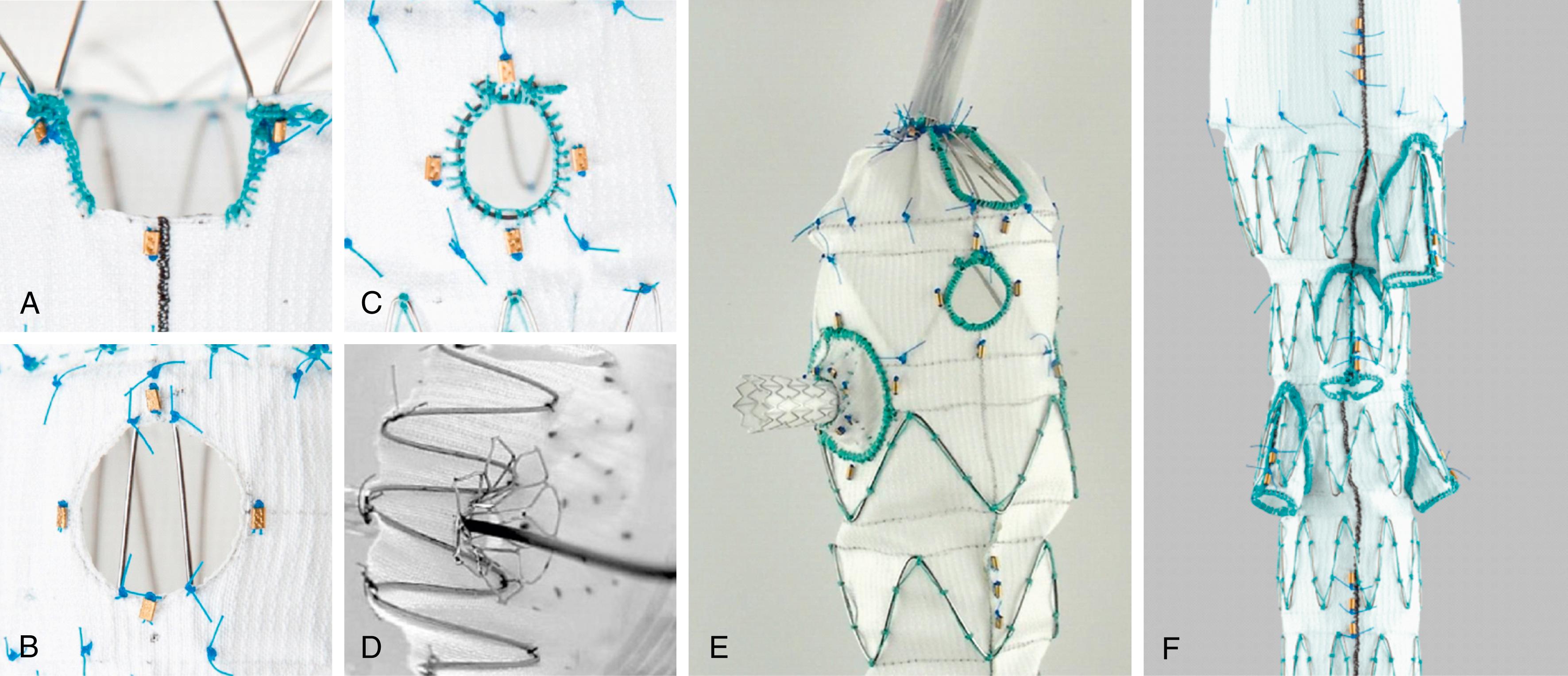
The term “branched aortic endograft” (BEVAR) refers to endovascular repair involving an aortic device that include directional branches. A branch is a cylindrical tube of fabric, which may be placed either internally or externally on the aortic endograft, and its origin can be located on the endograft proximal or distal to the origin of the target vessel. Branches have varied in configuration but have generally involved straight axial cuffs, directional cuffs, and helical limbs ( Fig. 82.2 ) of varying lengths. Branches require a stent graft to bridge the branch to the target artery origin to maintain target artery perfusion and to prevent flow into the aneurysm sac. The term “fenestrated–branched endovascular repair” (FBEVAR) is used when a combination of fenestrations and branches is used within the same device. Consensus has not emerged regarding the superiority of branches versus fenestrations, and most high-volume users would agree that there is a role for both methods in complex endovascular repair. ,
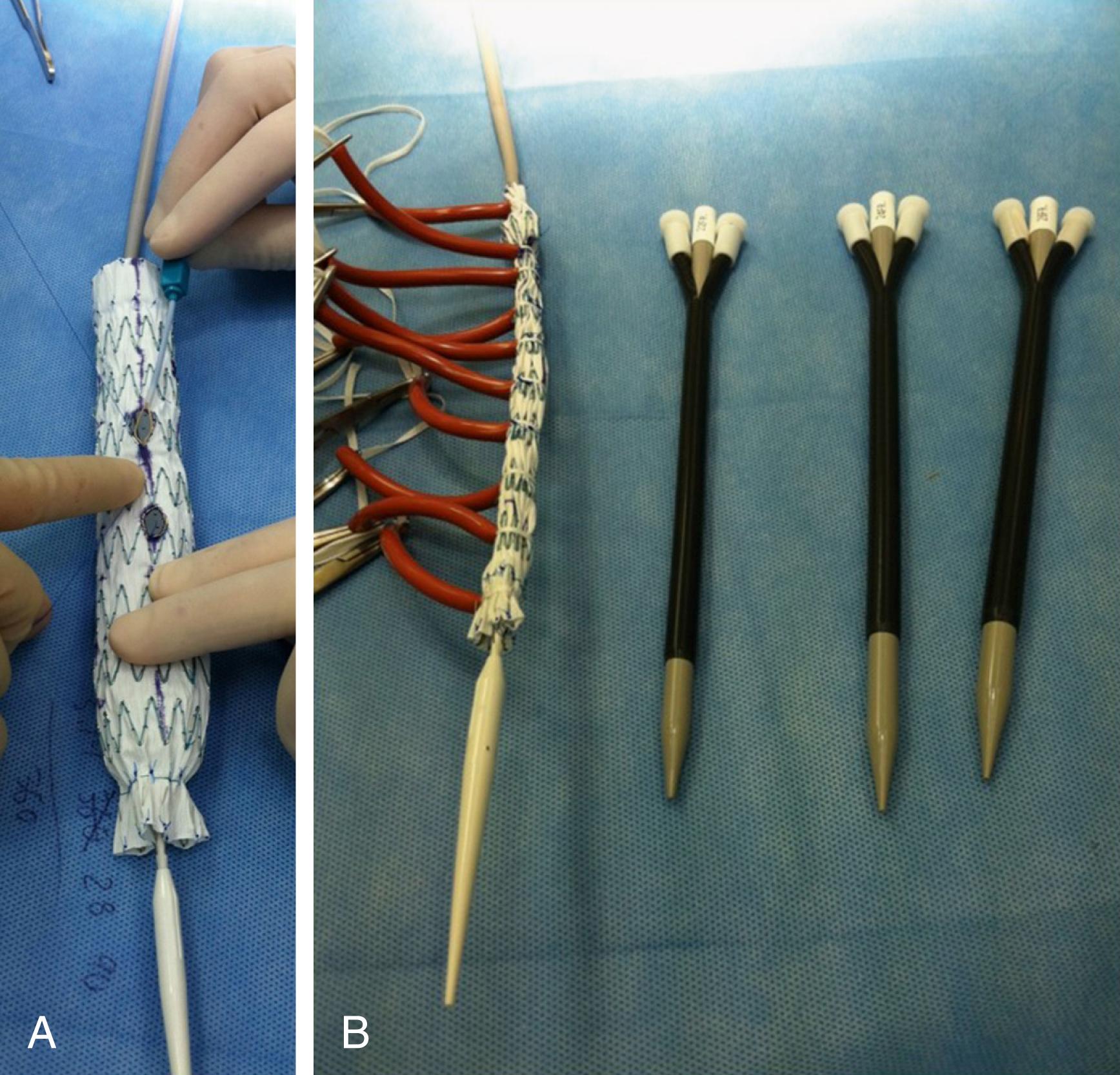
FBEVAR devices can be obtained in a variety of ways. These are generally grouped into physician-modified endografts (PMEGs), custom-made patient-specific devices (CMDs), or off-the-shelf designs which have been tested to be applicable to a variety of anatomic configurations. There are a number of pros and cons associated with each type.
To create a PMEG, a standard endograft is unsheathed on the back table under sterile conditions and modifications are created (branches and/or fenestrations) by hand to accommodate target vessels at locations specific to the patient’s anatomy ( Fig. 82.3 ). The modified endograft is then resheathed for insertion and deployment in the patient. The rationale for such an approach is twofold: (1) many institutions do not have access to CMDs, and (2) in urgent or emergent situations, there may not be time to wait the 6 to 8 weeks typically required for the manufacturing of a CMD. Numerous reports have described techniques for modifying nearly all of the devices that are presently commercially available for aneurysms of all extents and locations. Physician modification requires a detailed knowledge of devices and deployment mechanisms, and acceptance of some design limitations. It is imperative to note the serious responsibility assumed by the implanting physician, particularly if the procedure is not performed in the context of an investigational device exemption study.
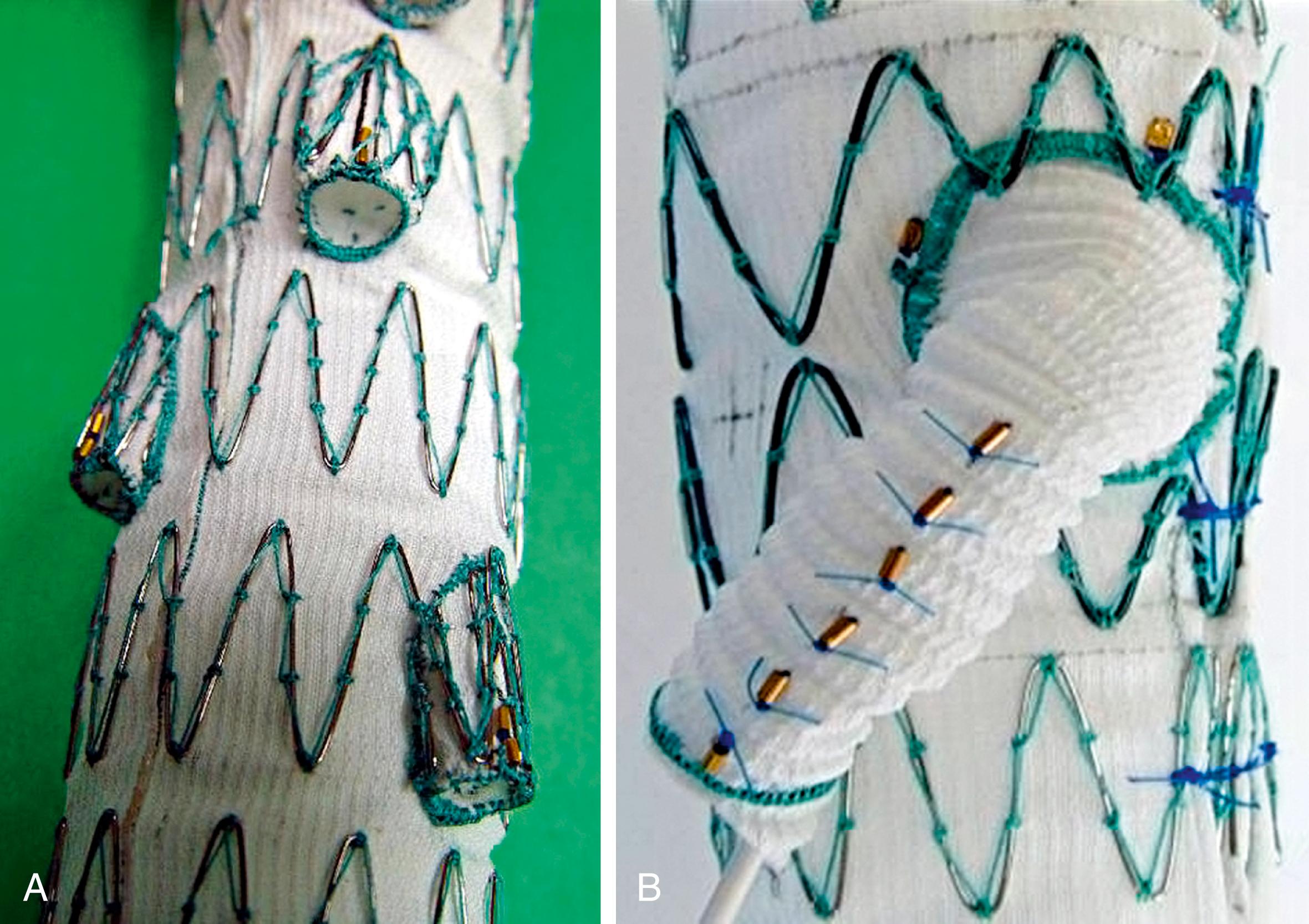
CMD are typically created with an industry partner. The majority of the experience with CMD to date is through the use of devices based off of the TX2 and Zenith platforms (Cook Medical). These devices can include any combination of fenestrations and/or branches. Often the device is “preloaded,” whereby a catheter and wire is threaded through the delivery system and then through the fenestration and/or branch ( Fig. 82.4 ). Preloaded catheters/wires can be used to facilitate FBEVAR in one of two ways: (1) snared from above to facilitate target artery cannulation from the brachial or axillary approach or (2) loaded from below to guide a sheath through the transfemoral ipsilateral delivery system and out the fenestration ( Fig. 82.5 ). Although these CMDs are commercially available throughout much of the world, they have limited availability in the United States. To date, other than the FDA-approved Zenith Fenestrated Device (Cook Medical), all CMDs that have been implanted in the United States have been done so as part of an industry-sponsored clinical trial or at a center with an ongoing PS-IDE trial. ,
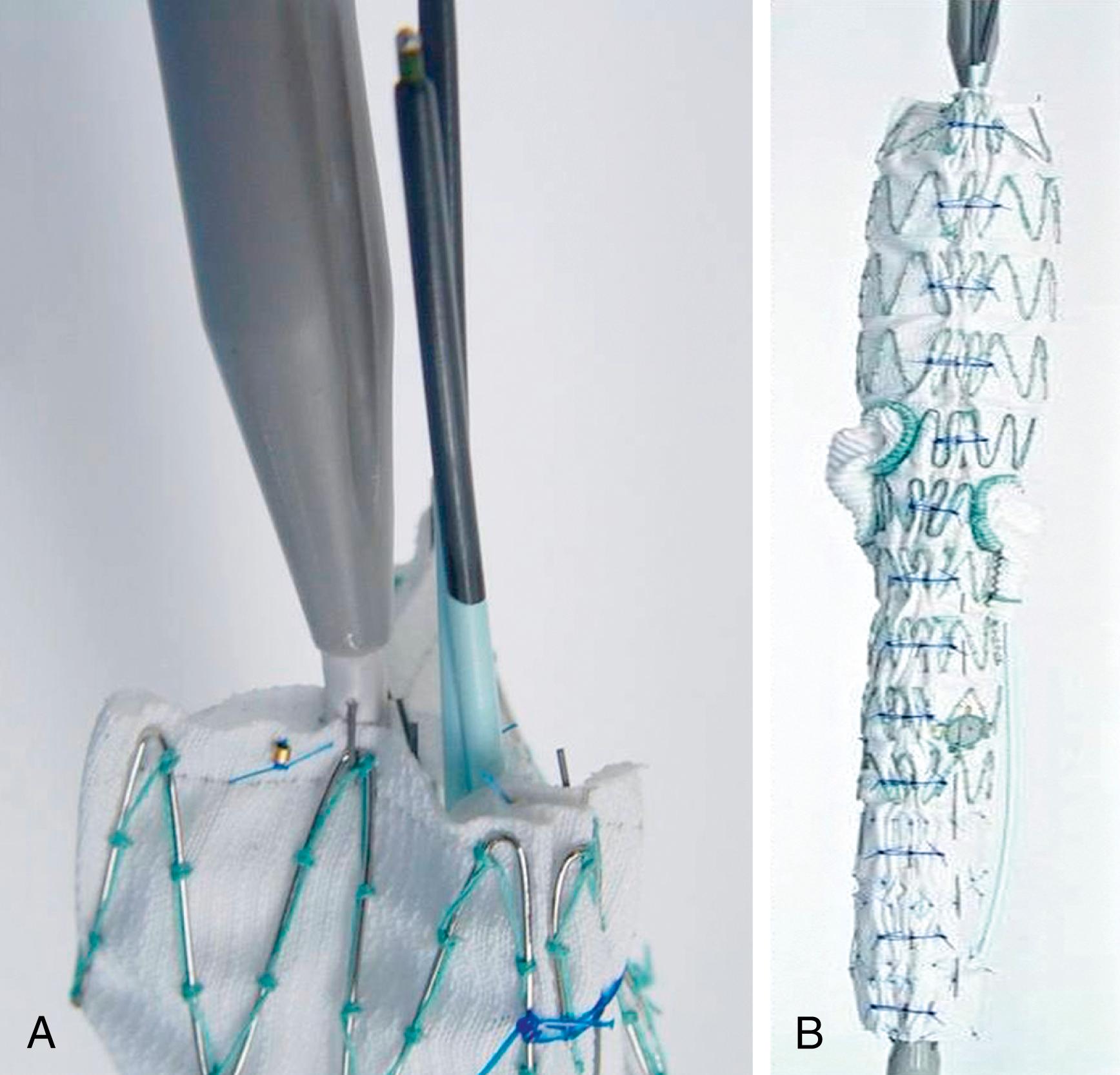
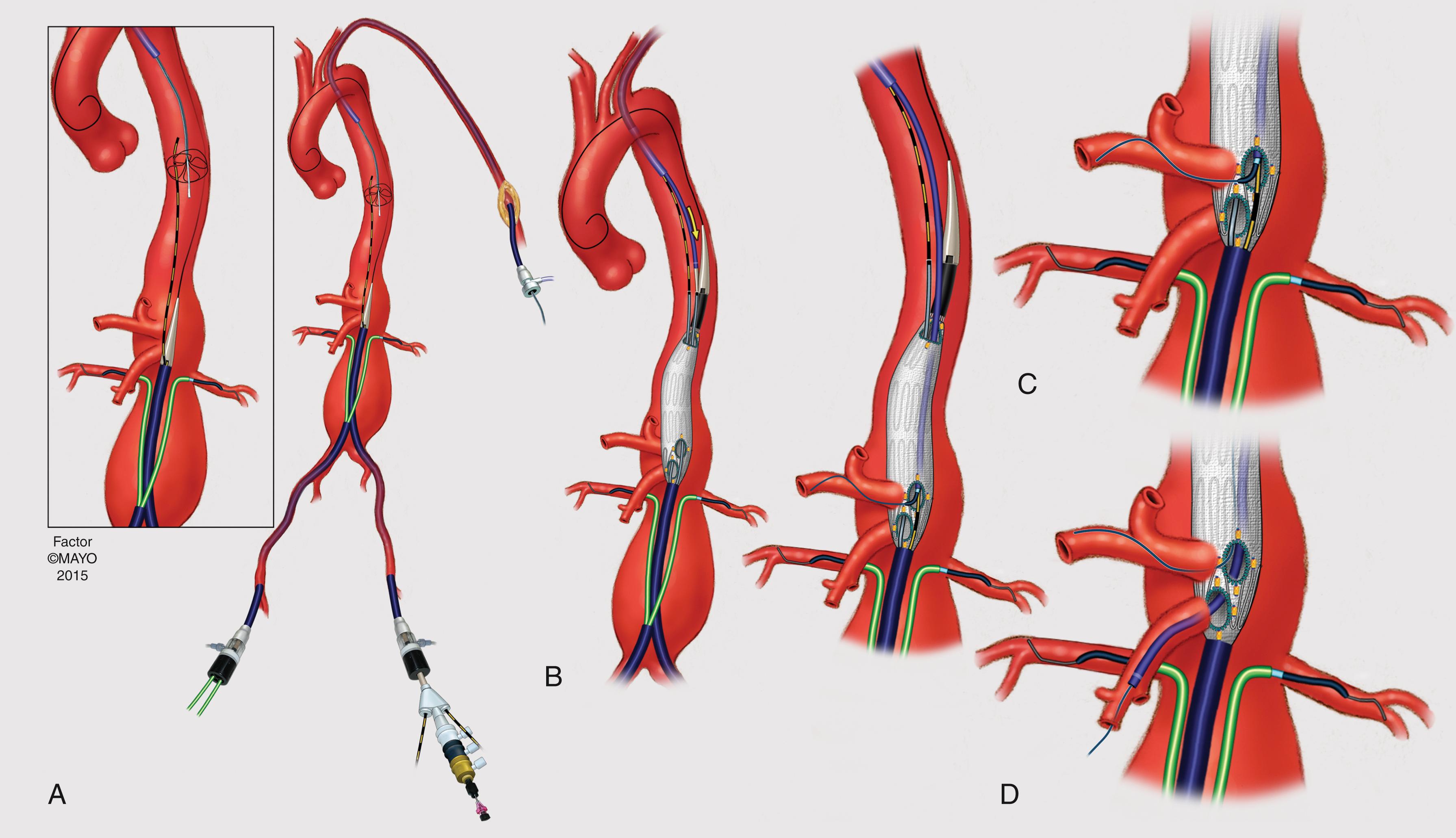
Off-the-shelf devices have been developed to allow for immediate availability of devices. Off-the-shelf designs take advantage of the fact that branch vessel anatomy varies within a defined range for the majority of patients. Pivoting fenestrations and down-going axial side branches have both been used to create different off-the-shelf devices applicable to different types of aneurysms. There are currently four different off-the-shelf FBEVAR devices in trial in the United States: Cook “p-Branch” (Cook Medical), “t-Branch” (Cook Medical), Gore Excluder Thoracoabdominal Multibranch Endoprosthesis (W. L. Gore and Associates, Inc., Flagstaff, AZ), and the Medtronic Valiant TAAA stent graft system (Medtronic, Minneapolis, MN). While these devices are more versatile than custom-made CMDs, off-the-shelf designs are not able to accommodate all extremes of anatomy.
Aneurysms are classified by the extent of the aorta that they involve and their relation to important arch or visceral branches. Historically, comparison of outcomes has relied on this classification system. Aortic endografting, however, challenges this classification scheme as the extent of aortic repair often extends beyond the scope of the underlying anatomic extent. The classification is based on the goal of sealing into healthy aorta, and as such, may “upstage” the repair to incorporate additional segments of aorta than would not be included in standard open repair. As such, devices designed for treatment of more extensive aneurysms can be used to treat lesser ones, but at an increased operative risk. Practitioners are encouraged to familiarize themselves with each device’s Indication for Use for detailed information. In addition, physician-modified endografts have been described for each location and will not be expanded upon here.
The commercially available Zenith Fenestrated Endovascular Graft (ZFEN device, Cook Medical) is intended to treat “short-neck” (4–10 mm) infrarenal AAA and is the only fenestrated device currently FDA-approved in the United States ( Fig. 82.6 ). The proximal main body is a tube graft incorporating a combination scallops and various sized fenestrations to incorporate the renals and superior mesenteric artery (SMA). The fenestrations can be small and reinforced or large with no reinforcement and crossed by a Z-stent strut. Bridging stents are used to align the small, reinforced fenestrations with the target vessels, while scallops and large fenestrations are not typically supported with additional bridging stent placement. The distal body is then mated with the iliac arteries using a bifurcate component and iliac limbs.
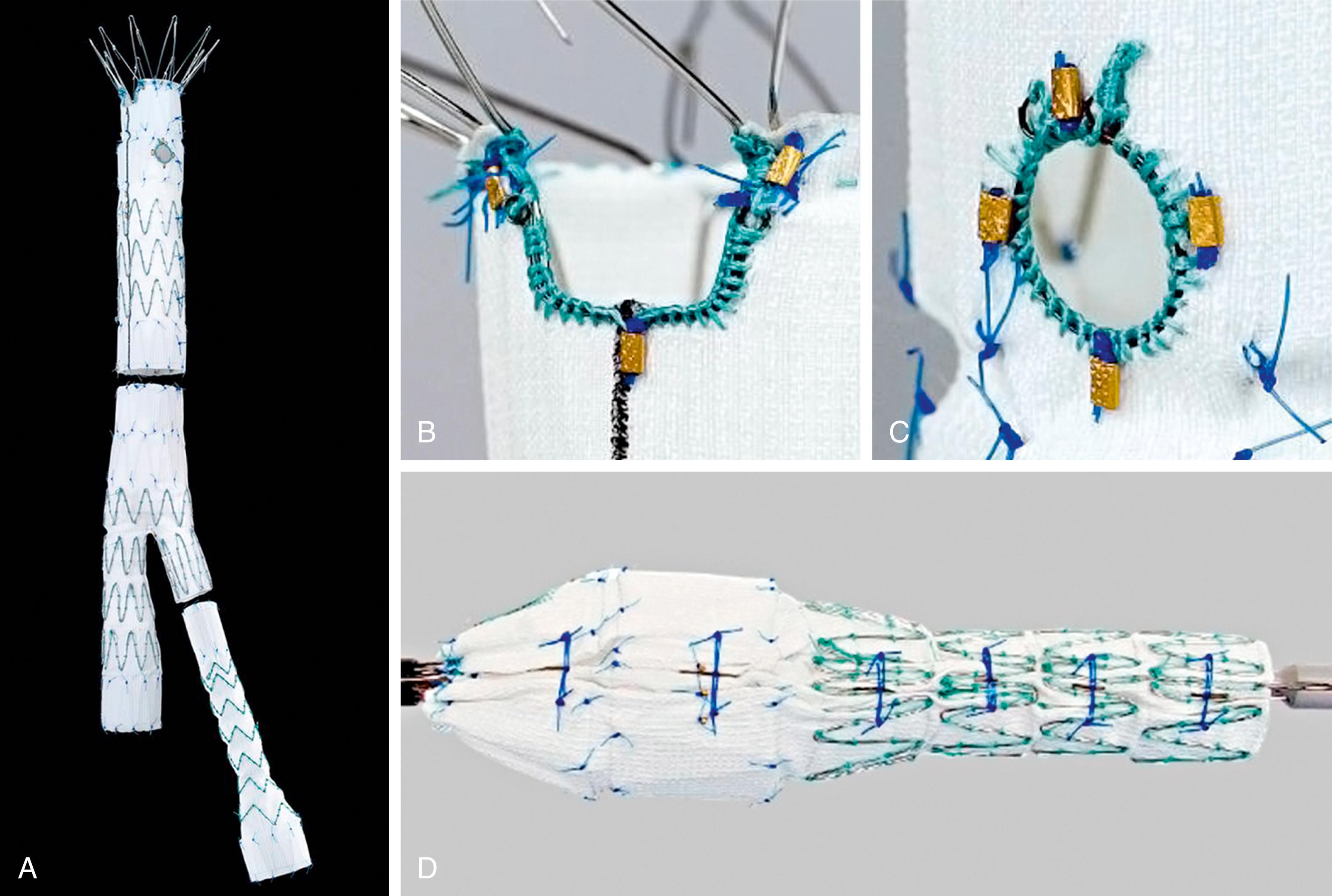
The Vascutek Fenestrated Anaconda Endograft (Vascutek) is based on the Anaconda EVAR graft and can accommodate up to four fenestrations allowing for treatment of pararenal aneurysms. The top two sealing stents are sinusoidal creating peaks and valleys, one of which can be “augmented” to accommodate either the celiac or the SMA in place of a fenestration, effectively functioning as a large scallop. This “augmented valley” can then be combined with either two or three fenestrations for the other reno-visceral vessels. Because the device is based on the Anaconda EVAR platform, the proximal portion is unsupported with the exception of the sealing stents, which allows for near-infinite variation in the position of fenestrations. This device is currently not available in the United States.
The Cook “p-Branch” device (Cook Medical), so named for the ability of the renal fenestrations to “pivot,” is currently in clinical trial within the United States. Initial short- and mid-term results, however, have confirmed feasibility. This is an off-the-shelf device which incorporates a scallop for the celiac artery, a fixed fenestration for the SMA and pivot fenestrations for the renal arteries. As an off-the-shelf device, it is currently manufactured in two configurations which are anticipated to accommodate the aortic branch anatomy in approximately 70% of pararenal aneurysms. The renal fenestrations are constructed with redundant fabric allowing them to pivot, accommodating a wider location of the target vessel. Access to these fenestrations is simplified with the use of preloaded wires and catheters designed to allow direct access to the fenestration through the delivery system. After proximal main body deployment and target vessel selection and stent graft placement, the remaining graft deployment proceeds similarly to the ZFEN device.
Custom-made devices (CMDs) include any combination of fenestrations and/or branches at virtually any circumferential clockface position and distance from either the top or bottom of the fabric of the main body. These are positioned based on individual patient anatomy. On average, these devices require 6 to 10 weeks of time for manufacturing. The construction design can include a variety of different fabric and stent properties, but they are often based on existing stent graft platforms unique to partnering manufacturers. The main body can comprise the entire repair or mate with a proximal thoracic endograft extension piece and/or distal bifurcate piece. A diverse array of preloaded wires and/or catheter combinations can be incorporated into the endograft design to facilitate target artery cannulation from either antegrade or retrograde cannulation. Worldwide, custom-made devices have been available based on Cook Medical, Bolton/Terumo, Medtronic and Jotec platforms. The largest experience in the United States is based on Cook Medical and are currently available only through investigational programs.
The Thoracic Branch or “t-Branch” device (Cook Medical) is an off-the-shelf device based on the Cook TX2 platform which uses four down-going axial branches, which allow for bridging with covered stents into the renovisceral vessels ( Fig. 82.7 ). It can be mated with a modular infrarenal bifurcated graft distally and/or a thoracic endograft proximally.

The TAMBE graft (W. L. Gore & Associates) is an off-the-shelf device designed for the treatment of aneurysms involving the visceral segment ( Fig. 82.8 ). The current graft design has four down-going internal branches for the celiac artery, SMA and renal arteries. These are bridged to the target vessels using the Gore VBX balloon-expandable stent graft. Preloaded guide wires are present to facilitate rapid cannulation. Early feasibility testing has been performed, and this device is currently under clinical trial in the United States.
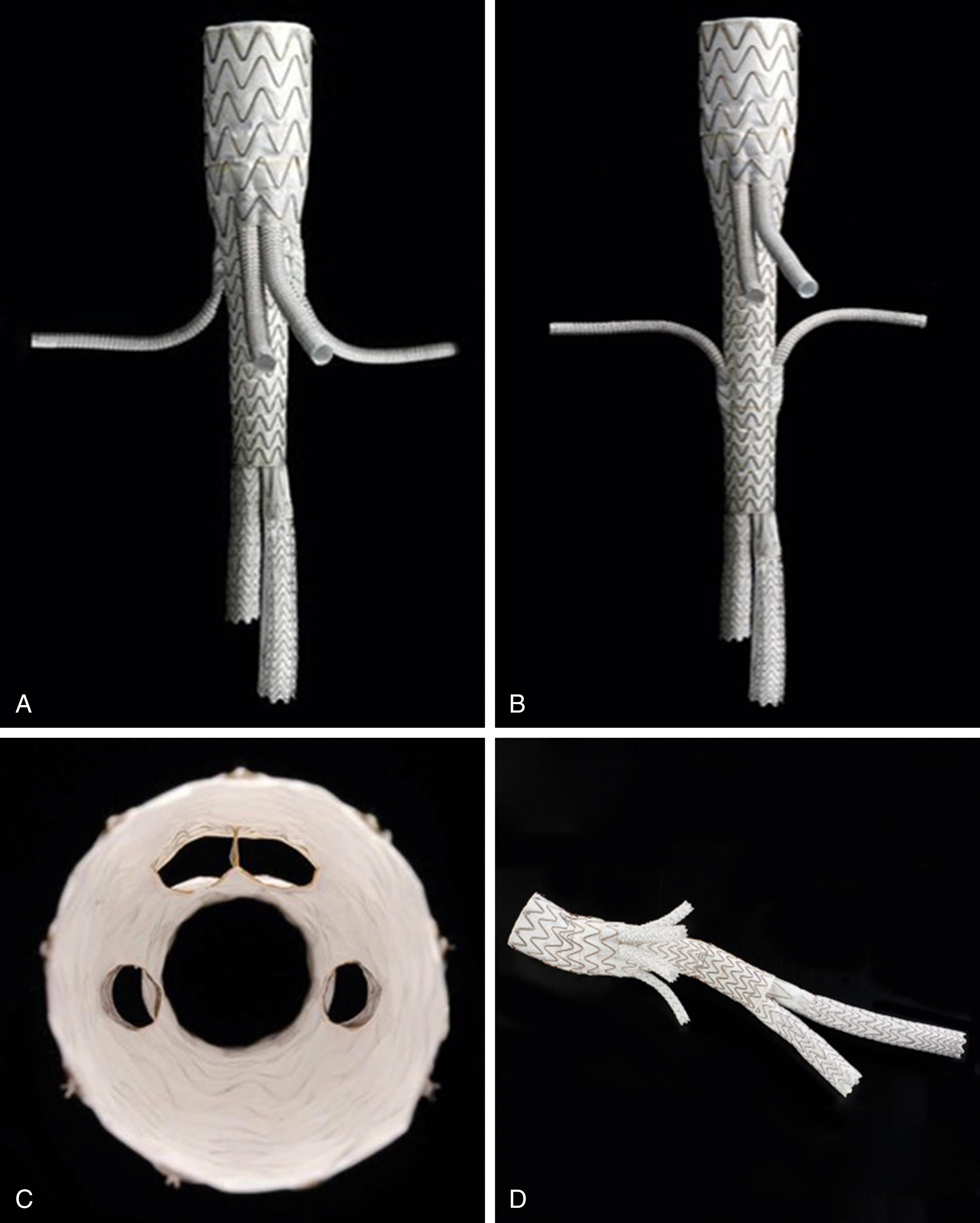
Fenestrated and branched technology has been applied to TEVAR involving the aortic arch. Challenges unique to the aortic arch include greater variability in flow dynamics, impulse, helical blood flow, and motion through the cardiac and respiratory cycles superimposed on an alternative aortic wall compliance, angulation, and tortuosity. These factors are not only salient to stent-graft design and long-term durability, but add to the challenge of accurate deployment which requires substantial technical prowess, precision, and efficiency given the proximity to the aortic valve, coronary arteries, and lower cerebral tolerance to transient ischemia and embolism. The technical challenges of arch repair and the desire for off-the shelf grafts has driven the development of the four commercial arch branch devices. Current grafts are in or planned to enter clinical trials in the United States or Europe. Alternatively, custom devices are available within some physician-sponsored IDE trials.
The Cook arch branch device can be customized with scallops, fenestrations and/or branches and is intended for zone 0 deployment. A key component of the delivery system is a precurved introducer and sheath and delivery mechanism which aids in orienting the internal branches along the outer curvature of the arch. After graft deployment, there is ongoing arch perfusion through the open branches. After surgical access from above (right carotid or axillary artery; left carotid or axillary artery in the setting of a left carotid subclavian bypass), the internal branches are cannulated and bridging stents deployed from the internal branch into the respective target vessels. This graft has the largest worldwide experience, with greater than 200 implants reported.
This device by Bolton Medical/Terumo Aortic, based on the Relay NBS platform, is available with one or two antegrade branches. A dual sheath design is meant to improve conformability along the inner curve of the arch, and a precurved nitinol hypo tube aids in orientation of the branches along the outer curve. The most current iteration of device includes two 12-mm internal “tunnels.” The tunnels open into a single large aperture which is meant to direct guide wires into the tunnels from a retrograde approach through bilateral carotid artery access. Dedicated bridging stent grafts, which accommodate the majority of innominate and carotid artery sizes, are part of the system. Previously only available in the Europe, the device has now entered clinical trials within the United States. The results of 40 implantations have been reported. ,
Become a Clinical Tree membership for Full access and enjoy Unlimited articles
If you are a member. Log in here